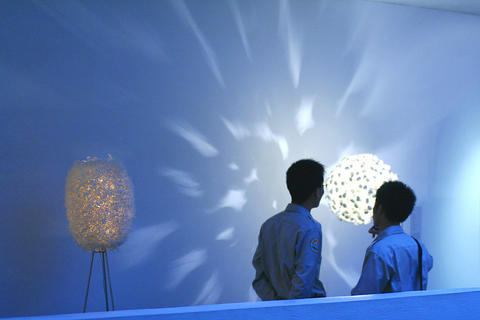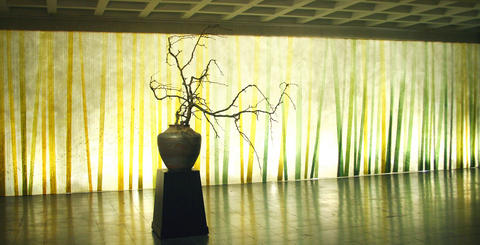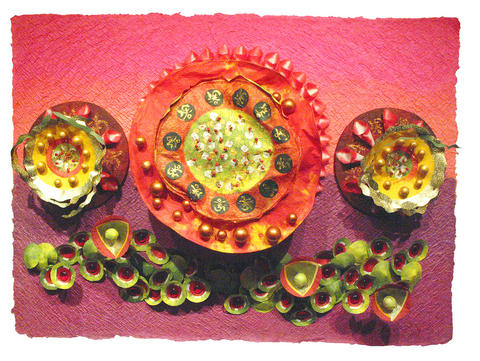Five decades after Chen Su-ho (陳樹火) founded one of the first factories specializing in handmade paper in Puli (埔里), Nantou County, his daughter has returned with an exhibition that gives the traditional craft a modern twist.
When Rita LiChen (陳瑞惠) was growing up, Puli was home to roughly 60 factories where paper was made by hand. Now only six remain. Watching the factories disappear - many moved to China - inspired her father to open a museum to preserve the memory of this chapter in Taiwan's cultural history.
LiChen's father died in a plane crash in 1990, but his dream lives on in the Suho Memorial Paper Museum (樹火紀念紙博物館) in Taipei. The museum is currently hosting its largest collaboration to date at the National Taiwan Craft Research Institute (國立台灣工藝研究所) in Nantou's Caotun Township (草屯). Zhi-Dao: Environment, Tranquility, Reverence (紙道:境,靜,敬) runs through April 27 and showcases the work of nine Taiwanese and international artists chosen by LiChen, who heads the Suho museum.

PHOTO: COURTESY OF TA YANG
"With this show, I wanted to destroy the entire concept of what 'paper' is," LiChen says. "Only by destroying this concept can artists find new ways to express themselves."
"Some people might think our work is too high-brow or think they can't understand it," she adds. "But I don't worry about that. If it's good, they'll naturally come to appreciate it."
Instead of selecting works by the best paper-makers and craftsmen in the field, Zhi-Dao presents a broad group of pieces ranging from paper-based lampshades and jewelry to contemporary art installations like Zeng Pei-ling's (曾沛玲) Tibetan Bhuddism-influenced wall hangings.

PHOTO: COURTESY OF TA YANG
Out of all the artists whose work is on display, Li Chao-cang (李朝倉) seems most set on pushing the boundaries of what "paper" is. Li has wrapped the entrance of the hall in a stretched white polyester tunnel that viewers have to duck through to access his main piece, a crude assemblage of reeds and other materials gathered from Nantou's flora and tied together to resemble the bamboo scaffolding commonly seen at construction sites.
Japanese artist Kobayashi Junko's Bamboo Forest, a giant 50m-by-3m sheet of paper that required the strength of 15 workers to lift and install, encircles the hall's second floor and dominates the exhibit. The paper's dyed vertical stripes gradually shift in hue as the viewer follows the piece around the room, suggesting the changing seasons. Delicate white paper slippers by Zhou Meng-ye (周孟曄) lie scattered in front of the piece. With a reflective score written for the show by Belgian composer Pierre Hujoel, the space exudes an air of serenity that makes viewers want to slip off their shoes and forget the winter cold and bustle of the holiday season.
A visit to the hall's fourth floor - not a part of the Zhi-Dao exhibit - gives visitors an idea of how irreverent LiChen's transformation of the conservative, craft-oriented institute was. Stone teapots carefully hewn to look like old wood, intricately carved bamboo frogs, wicker insects and lacquerware are displayed in glass cases, often with price tags next to them. Not quite the stuff of a modern art gallery.

PHOTO: COURTESY OF TA YANG
Plans for the exhibit met with opposition from staff at the cultural hall, though not from its director. Since the show runs through the Lunar New Year - a time to celebrate beginnings - some said Li's white tunnel wasn't appropriate because the color is traditionally associated with funerals and death. Three large white banners that were to be hung outside the hall advertising the show had to be redesigned, but Li's tunnel stayed.
LiChen has spent 13 years running the Suho Museum, which opened in 1995 after years of planning by her and her siblings. The museum is part of the Suho Memorial Paper Culture Foundation (樹火紀念紙文化基金會), founded after they lost both their parents in a plane crash. Eighteen years after the tragedy, Zhi-Dao is not only a remembrance of things past, but also a challenge to move forward.

PHOTO: BLAKE CARTER, TAIPEI TIMES

The canonical shot of an East Asian city is a night skyline studded with towering apartment and office buildings, bright with neon and plastic signage, a landscape of energy and modernity. Another classic image is the same city seen from above, in which identical apartment towers march across the city, spilling out over nearby geography, like stylized soldiers colonizing new territory in a board game. Densely populated dynamic conurbations of money, technological innovation and convenience, it is hard to see the cities of East Asia as what they truly are: necropolises. Why is this? The East Asian development model, with

June 16 to June 22 The following flyer appeared on the streets of Hsinchu on June 12, 1895: “Taipei has already fallen to the Japanese barbarians, who have brought great misery to our land and people. We heard that the Japanese occupiers will tax our gardens, our houses, our bodies, and even our chickens, dogs, cows and pigs. They wear their hair wild, carve their teeth, tattoo their foreheads, wear strange clothes and speak a strange language. How can we be ruled by such people?” Posted by civilian militia leader Wu Tang-hsing (吳湯興), it was a call to arms to retake

This is a deeply unsettling period in Taiwan. Uncertainties are everywhere while everyone waits for a small army of other shoes to drop on nearly every front. During challenging times, interesting political changes can happen, yet all three major political parties are beset with scandals, strife and self-inflicted wounds. As the ruling party, the Democratic Progressive Party (DPP) is held accountable for not only the challenges to the party, but also the nation. Taiwan is geopolitically and economically under threat. Domestically, the administration is under siege by the opposition-controlled legislature and growing discontent with what opponents characterize as arrogant, autocratic

When Lisa, 20, laces into her ultra-high heels for her shift at a strip club in Ukraine’s Kharkiv, she knows that aside from dancing, she will have to comfort traumatized soldiers. Since Russia’s 2022 invasion, exhausted troops are the main clientele of the Flash Dancers club in the center of the northeastern city, just 20 kilometers from Russian forces. For some customers, it provides an “escape” from the war, said Valerya Zavatska — a 25-year-old law graduate who runs the club with her mother, an ex-dancer. But many are not there just for the show. They “want to talk about what hurts,” she